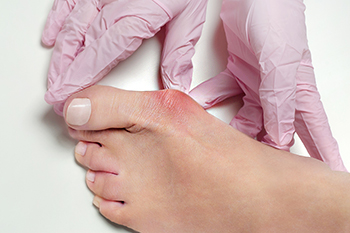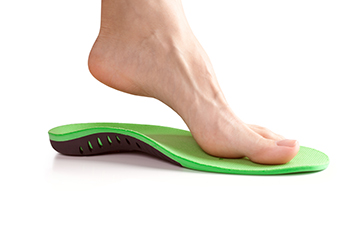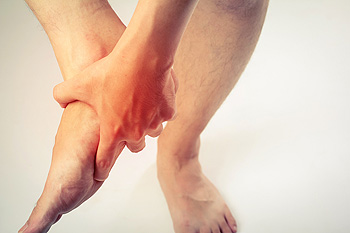Connect With Us
Blog
Items filtered by date: July 2024
Common Foot Injuries in Figure Skating and Their Causes

Figure skating often leads to various foot injuries due to the sport's demands. Stress fractures are common, resulting from repetitive impact on the ice. Tendonitis occurs from overuse and the repetitive movements involved in jumps and spins. Bursitis in the ankle is another frequent issue, caused by inflammation of the bursae due to friction and pressure. Lace bite, characterized by pain and swelling on the top of the foot, results from tight skate laces. Additionally, boot stiffness can contribute to these injuries by restricting natural foot movement and causing pressure points. Improper blade placement affects balance and alignment, increasing the risk of falls and stress injuries. Blade sharpness is essential, as dull blades require more effort to maneuver, leading to overexertion. Foot and ankle injuries are treated by a podiatrist. If you enjoy ice skating and have sustained this type of injury, it is suggested that you consult a podiatrist for a comprehensive treatment plan.
Ankle and foot injuries are common among athletes and in many sports. They can be caused by several problems and may be potentially serious. If you are feeling pain or think you were injured in a sporting event or when exercising, consult with Magdy Issa, DPM from Charlotte Family Podiatry and Wound Center. Our doctor will assess your condition and provide you with quality foot and ankle treatment.
Common Injuries
The most common injuries that occur in sporting activities include:
- Achilles Tendonitis
- Achilles Tendon Rupture
- Ankle Sprains
- Broken Foot
- Plantar Fasciitis
- Stress Fractures
- Turf Toe
Symptoms
Symptoms vary depending upon the injury and in some cases, there may be no symptoms at all. However, in most cases, some form of symptom is experienced. Pain, aching, burning, bruising, tenderness, tightness or stiffness, sensation loss, difficulty moving, and swelling are the most common symptoms.
Treatment
Just as symptoms vary depending upon the injury, so do treatment options. A common treatment method is known as the RICE method. This method involves rest, applying ice, compression and elevating the afflicted foot or ankle. If the injury appears to be more serious, surgery might be required, such as arthroscopic or reconstructive surgery. Lastly, rehabilitation or therapy might be needed to gain full functionality in the afflicted area. Any discomfort experienced by an athlete must be evaluated by a licensed, reputable medical professional.
If you have any questions, please feel free to contact our office located in Charlotte, NC . We offer the newest diagnostic and treatment technologies for all your foot care needs.
Stiff Big Toe Pain
 Hallux rigidus, or stiff big toe, is a form of arthritis affecting the joint at the base of the big toe, leading to pain and stiffness. This condition occurs due to the wear and tear of the cartilage in the joint, which can be accelerated by repetitive stress, injury, or genetic predisposition. It commonly affects adults over 30, especially those with a history of foot injuries, or occupations that place significant stress on the feet. Symptoms can include pain and stiffness in the big toe during movement, swelling surrounding the joint, and difficulty in bending the toe. Over time, bone spurs may develop, further limiting motion and causing discomfort. Complications of untreated hallux rigidus can include chronic pain, difficulty walking, and an altered gait, leading to additional foot, knee, hip, or back problems. Prevention involves wearing supportive shoes with a wide toe box, avoiding high heels, and performing foot exercises to maintain flexibility. Treatment options range from non-surgical methods, such as anti-inflammatory medications, orthotics, and targeted stretching exercises, to surgical intervention, in severe cases. If you have a stiff and painful big toe, it is suggested that you schedule an appointment with a podiatrist for an accurate diagnosis and effective treatment.
Hallux rigidus, or stiff big toe, is a form of arthritis affecting the joint at the base of the big toe, leading to pain and stiffness. This condition occurs due to the wear and tear of the cartilage in the joint, which can be accelerated by repetitive stress, injury, or genetic predisposition. It commonly affects adults over 30, especially those with a history of foot injuries, or occupations that place significant stress on the feet. Symptoms can include pain and stiffness in the big toe during movement, swelling surrounding the joint, and difficulty in bending the toe. Over time, bone spurs may develop, further limiting motion and causing discomfort. Complications of untreated hallux rigidus can include chronic pain, difficulty walking, and an altered gait, leading to additional foot, knee, hip, or back problems. Prevention involves wearing supportive shoes with a wide toe box, avoiding high heels, and performing foot exercises to maintain flexibility. Treatment options range from non-surgical methods, such as anti-inflammatory medications, orthotics, and targeted stretching exercises, to surgical intervention, in severe cases. If you have a stiff and painful big toe, it is suggested that you schedule an appointment with a podiatrist for an accurate diagnosis and effective treatment.
Arthritis can be a difficult condition to live with. If you are seeking treatment, contact Magdy Issa, DPM from Charlotte Family Podiatry and Wound Center. Our doctor can provide the care you need to keep you pain-free and on your feet.
Arthritic Foot Care
Arthritis is a joint disorder that involves the inflammation of different joints in your body, such as those in your feet. Arthritis is often caused by a degenerative joint disease and causes mild to severe pain in all affected areas. In addition to this, swelling and stiffness in the affected joints can also be a common symptom of arthritis.
In many cases, wearing ill-fitting shoes can worsen the effects and pain of arthritis. Wearing shoes that have a lower heel and extra room can help your feet feel more comfortable. In cases of rheumatoid arthritis, the arch in your foot may become problematic. Buying shoes with proper arch support that contour to your feet can help immensely.
Alleviating Arthritic Pain
- Exercises that stretch the foot can prevent further pain and injury and increase mobility
- Most of the pain can be alleviated with anti-inflammatory drugs, heat, and topical medications
- Massages can help temporarily alleviate pain.
It is best to see your doctor for the treatment that is right for your needs and symptoms. Conditions vary, and a podiatrist can help you determine the right method of care for your feet.
If you have any questions, please feel free to contact our office located in Charlotte, NC . We offer the newest diagnostic tools and technology to treat your foot and ankle needs.
Get Proper Treatment for Ankle Injuries
Orthotics Can Help With Arch Support

Proper arch support is essential for maintaining foot health and preventing discomfort. While over-the-counter arch supports are available at many sports and shoe stores, custom orthotics prescribed by a podiatrist can offer personalized relief for those suffering from arch pain. These medical devices are designed and created specifically for your foot. Customized orthotics for arch support help to rebuild the foot’s natural strength by providing targeted support, thereby preventing further injury and aiding in the repair of existing damage. The rigidity of these supports ensures that the arches remain elevated while allowing some flexibility for natural movement. In severe cases, continuous support methods like taping can be beneficial, providing consistent arch stability even when barefoot. Consulting with a podiatrist is vital for ensuring the proper fit and function of your orthotic device, as improperly fitted supports can cause additional harm. If you are experiencing arch pain, it is suggested that you make an appointment with a podiatrist for an exam and treatment.
If you are having discomfort in your feet and would like to try orthotics, contact Magdy Issa, DPM from Charlotte Family Podiatry and Wound Center. Our doctor can provide the care you need to keep you pain-free and on your feet.
What Are Orthotics?
Orthotics are inserts you can place into your shoes to help with a variety of foot problems such as flat feet or foot pain. Orthotics provide relief and comfort for minor foot and heel pain but can’t correct serious biomechanical problems in your feet.
Over-the-Counter Inserts
Orthotics come in a wide variety of over-the-counter inserts that are used to treat foot pain, heel pain, and minor problems. For example, arch supports can be inserted into your shoes to help correct overarched or flat feet, while gel insoles are often used because they provide comfort and relief from foot and heel pain by alleviating pressure.
Prescription Orthotics
If over-the-counter inserts don’t work for you or if you have a more severe foot concern, it is possible to have your podiatrist prescribe custom orthotics. These high-quality inserts are designed to treat problems such as abnormal motion, plantar fasciitis, and severe forms of heel pain. They can even be used to help patients suffering from diabetes by treating foot ulcers and painful calluses and are usually molded to your feet individually, which allows them to provide full support and comfort.
If you are experiencing minor to severe foot or heel pain, it’s recommended to speak with your podiatrist about the possibilities of using orthotics. A podiatrist can determine which type of orthotic is right for you and allow you to take the first steps towards being pain-free.
If you have any questions please contact our office located in Charlotte, NC . We offer the newest diagnostic and treatment technologies for all your foot and ankle needs.
The Pain of Plantar Fasciitis
 Plantar fasciitis is a common foot condition characterized by inflammation of the plantar fascia, a thick band of tissue that runs along the bottom of the foot, connecting the heel bone to the toes. It occurs when this tissue is overstretched or overused, often due to excessive running, standing for long periods, or wearing inadequate footwear. The condition manifests as a sharp, stabbing pain in the heel, particularly noticeable with the first steps in the morning or after long periods of inactivity. Those at higher risk include runners, individuals with high arches or flat feet, people who are overweight, and people who wear shoes with poor arch support. Preventing plantar fasciitis involves wearing supportive footwear, maintaining a healthy weight, and incorporating stretching exercises into daily routines to improve flexibility. Treatment options include rest and stretching exercises, For persistent pain, custom orthotics may be necessary. If you have continued heel pain, it is suggested that you schedule an appointment with a podiatrist for a proper diagnosis and treatment.
Plantar fasciitis is a common foot condition characterized by inflammation of the plantar fascia, a thick band of tissue that runs along the bottom of the foot, connecting the heel bone to the toes. It occurs when this tissue is overstretched or overused, often due to excessive running, standing for long periods, or wearing inadequate footwear. The condition manifests as a sharp, stabbing pain in the heel, particularly noticeable with the first steps in the morning or after long periods of inactivity. Those at higher risk include runners, individuals with high arches or flat feet, people who are overweight, and people who wear shoes with poor arch support. Preventing plantar fasciitis involves wearing supportive footwear, maintaining a healthy weight, and incorporating stretching exercises into daily routines to improve flexibility. Treatment options include rest and stretching exercises, For persistent pain, custom orthotics may be necessary. If you have continued heel pain, it is suggested that you schedule an appointment with a podiatrist for a proper diagnosis and treatment.
Plantar fasciitis can be very painful and inconvenient. If you are experiencing heel pain or symptoms of plantar fasciitis, contact Magdy Issa, DPM from Charlotte Family Podiatry and Wound Center. Our doctor can provide the care you need to keep you pain-free and on your feet.
What Is Plantar Fasciitis?
Plantar fasciitis is the inflammation of the thick band of tissue that runs along the bottom of your foot, known as the plantar fascia, and causes mild to severe heel pain.
What Causes Plantar Fasciitis?
- Excessive running
- Non-supportive shoes
- Overpronation
- Repeated stretching and tearing of the plantar fascia
How Can It Be Treated?
- Conservative measures – anti-inflammatories, ice packs, stretching exercises, physical therapy, orthotic devices
- Shockwave therapy – sound waves are sent to the affected area to facilitate healing and are usually used for chronic cases of plantar fasciitis
- Surgery – usually only used as a last resort when all else fails. The plantar fascia can be surgically detached from the heel
While very treatable, plantar fasciitis is definitely not something that should be ignored. Especially in severe cases, speaking to your doctor right away is highly recommended to avoid complications and severe heel pain. Your podiatrist can work with you to provide the appropriate treatment options tailored to your condition.
If you have any questions please feel free to contact our office located in Charlotte, NC . We offer the newest diagnostic and treatment technologies for all your foot and ankle needs.

